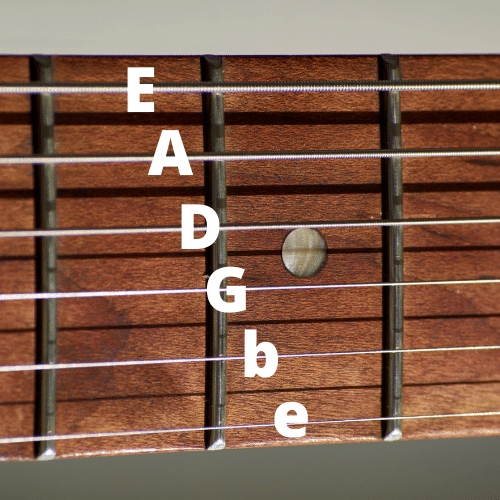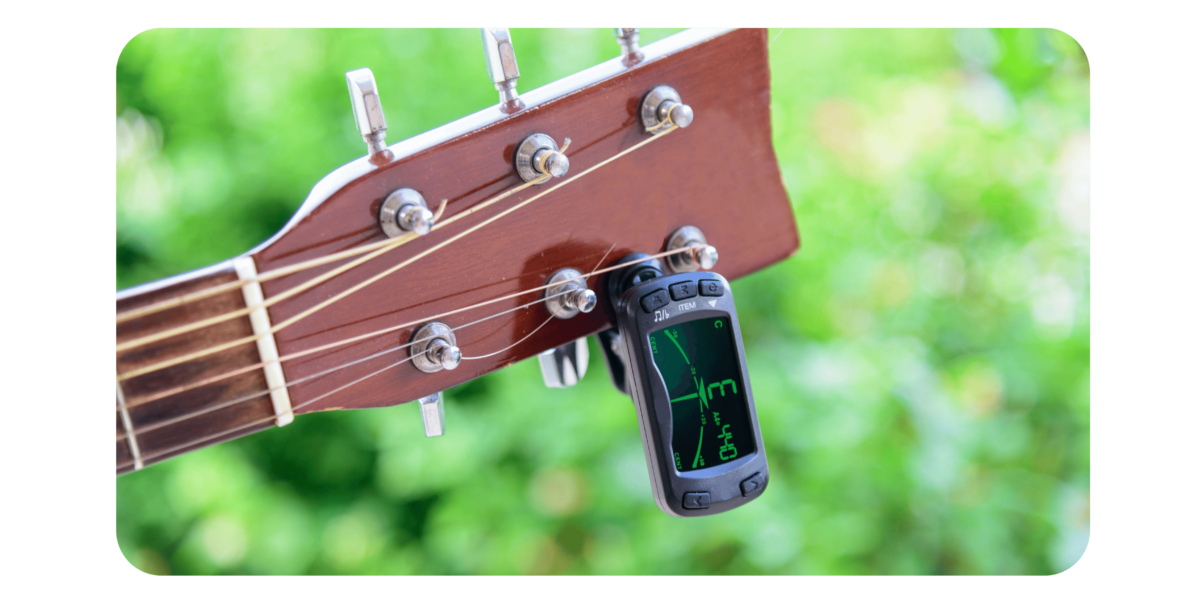How to Tune a Guitar

The first thing you should do when you pick up a guitar is check whether it’s in tune. In this article, we’ll teach you how to tune a guitar properly.
You’re sitting around with friends and want to impress them with a new song. You’ve been practicing at home. You know all the chords and lyrics. You pick up the guitar, take a deep breath, place fingers on the fretboard, and strum.
This doesn’t sound like the chord you practiced! Don’t worry. You probably haven’t made any mistakes. You just needed to check if the guitar was in tune because very often, they’re not. In this article, we explain all there is to know about guitar tuning so that you’ll be pitch perfect the next time this happens.
Why does my guitar sound out of tune?
Guitars work like most other stringed instruments. It has a long neck with five strings. The guitarist picks or strums the strings with their right hand, each with a different pitch according to how tightly it is pulled.
With the left hand, the guitarist presses down their fingers on the fretboard, allowing them to tighten the strings in small increments. Each square of the fretboard is a half-step from the one next.
Guitar strings are temperamental. They are very strongly affected by the weather and by movement. Their resistance to going out of tune depends mainly on the type of guitar, the strings’ material, and the guitarist’s playing. Generally, the strings loosen when the weather is hotter; the strings tighten in cold winter. Don’t be confused by it – it’s normal! You should tune your guitar every time you pick it up to play. To help your guitar stay in tune, you should change its strings often and protect it with a case.

What are the notes to tune a guitar?
There are various tunings for guitar strings, but the standard tuning is as follows, from bottom to top:
Another famous tuning for guitar is what we call “Dadgad.”
As you can see, some notes don’t change, and the others move no more than a tone away from their standard tuning. Of course, it may snap if you try to tighten a string too high. If you try to loosen a string too low, it may fall off the guitar. So most alternative guitar tunings remain within a tone of the standard tuning.
How to tune a guitar with a tuner.
There are all different kinds of tuners for guitars. Which one is right for you? It partly depends on the context of your playing.
You’ve probably already figured this out if you’re a performing musician on stage. But there is a small pedal, a matchbox size, which you plug into your guitar through the stage’s sound system. It has a button that you press with your foot, which mutes the guitar. Then, as you play each string, there is a small screen on the pedal, showing you if the note is in tune and whether it needs to be tightened or loosened until it’s perfect.

Another option is a small tuner which you clip onto the end of your guitar’s neck. With the press of a button, the tuner switches on and picks up the resonance of the strings. It works with a similar mechanism—a small screen showing whether the string is too high, too low, or just right. Check out something like this if you’re interested.
Finally, we have what all the cool kids are doing today – a tuning app. This is less practical for a gig. Sometimes even in a music lesson or a jam with friends, pulling out a phone can kill the vibe. But it’s convenient and good to have handy in your app folders. It works in the same fashion as the other tuners we described.
It just happens that we have the perfect tuner for you with Simply Tune.
How to tune a guitar without a tuner.
If you are an experienced musician with a refined ear, you could probably tune a guitar without any external device. You might just need a reference from another instrument or a song whose key you know. You can tune the rest of the strings using relative pitch by comparing each one to the first string and adjusting the tuning according to the appropriate interval. For example, once you verify the pitch of the bottom E string, you know that the next string up should be a perfect fourth interval away.
However, not all of us are Jacob Collier. Check out this article about Ear Training for Beginners to improve your ears.
It’s safe to say that if you’re a regular human musician and don’t have a tuner, you should probably use a piano or piano app to tune your guitar.
- Sit by the piano with your guitar in hand.
- Press your foot down on the sustain pedal of the piano.
- Play the note E, which is below middle C. Let it resonate.
- Play the bottom string of your guitar, which is also the note E. Do it quickly before the piano note fades and its sound changes.
- If the guitar string sounds lower than the piano key, tighten the string by turning it anticlockwise. If the string sounds higher than the key, loosen it by turning it clockwise.
- Using your ear and intuition, move on to the next string when the two instruments sound like they’re creating the same frequency.
- Repeat this process with all the strings, ascending on the piano with the notes A, D, G, B, and E. If you need assistance, do this process with the help of an instructional video.
- When you’ve reached the top string of the guitar, and it sounds in tune, plays an E major chord on the guitar without using the piano. This ensures that the guitar is in tune with itself and sounds good on its own. If it does, you’re ready to rock and roll.
What would you say if I sang out of tune?
Honestly, nobody would care since perfect pitch doesn’t exist. Sound travels in waves, and almost every time you hear a note, it sounds slightly different. As humans tend to, we strive for precision because there is something eerily moving about an instrument playing in perfect harmony.
And yet, don’t get too caught up in it – perfectionism can ruin all the vibe, spirit, and love that music can bring us. The most important thing is connecting to the song, feeling comfortable on the instrument, and singing your heart out.









